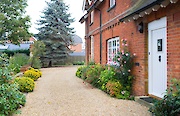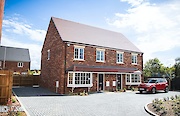


Content Writer

Mortgage Advisor & Director

If your property is built using materials or methods that don’t qualify as standard construction (i.e. bricks and mortar with a slate or tile roof), you may need a non-standard construction home insurance policy. These types of homes come with unique risks, so you may need a specialist provider.
Here, we’ll explain how non-standard home insurance works, average costs across the UK, and where to find and compare cheap tailored quotes.
Can you get home insurance on a non-standard construction property?
Yes, you can insure a non-standard construction home, but it typically requires a specialist insurer or a tailored policy. That’s because properties that aren’t built using standard construction methods are often considered higher risk, whether due to structural considerations, unusual materials, or maintenance requirements.
Some examples of non-standard construction properties include:
-
Thatched roofs
-
Flat roofs covering a portion of the property (usually 25% or more)
-
Glass, metal, or mixed-material walls
These characteristics can affect how the building performs over time, particularly in terms of insulation, fire safety, or weather resistance. As a result, standard insurers may struggle to accurately calculate premiums to cover certain repair costs, which is where non-standard home insurance comes in.
How insurers assess applications
Insurers will carry out a more detailed assessment when evaluating a non-standard construction home compared to a traditional property. Here are some of the key areas that will impact your eligibility and premiums for home insurance:
-
Construction and materials: The exact type of construction and the materials used for different parts of the house can all carry varying risks. For example, thatched roofs may pose a higher fire risk, while flat roofs are more prone to water ingress. So, home insurers will want specific details.
-
Age and condition: Older homes made with non-standard materials may degrade faster than standard counterparts, especially if not regularly maintained. Insurers may ask for a survey or evidence of renovations. There are also specific periods (like post-WW2), where some homes were quickly built using less-than-ideal methods.
-
Location and exposure to risk: Your postcode and proximity to environmental risks like flood zones or subsidence-prone land will influence home insurance premiums. Non-standard buildings may also be more susceptible to weather conditions like storms or fires.
-
Rebuild costs: The cost to rebuild a non-standard home can be higher than its market value, similar to listed buildings. That’s due to the potential need for specialist materials, construction expertise, or planning permissions. Insurers typically want an up-to-date rebuild cost estimate, possibly from a chartered surveyor.
-
Type of insurance and level of cover: Whether you just want home insurance or combined home and contents insurance will make an impact. Each insurer will also offer varying levels of cover, with cheaper policies sometimes having lower limits or specific exclusions. The amount of voluntary excess you pay can also have an impact.
-
Occupancy and use: If the home is used as a holiday let, second home, or remains unoccupied for extended periods, this will likely affect eligibility and premiums. Some insurers only offer cover for primary residential residences, but an adviser can help find the best solution.
Average cost of non-standard construction home insurance
Unfortunately, working out average costs for non-standard construction home insurance can vary widely depending on the property’s characteristics. This is due to the unique nature of non-standard homes, often requiring bespoke policies or home insurance tailored to that specific property and your individual insurance needs.
However, here are some rough estimates and averages:
|
Type of non-standard construction |
Average yearly cost |
|
Timber frame |
£288 |
|
Thatched roof |
£1,788 |
|
Prefab house |
£271 |
|
Grade 1 listed building |
£648 |
|
Corrugated iron walls |
£275 |
|
Stone walls |
£211 |
Get a bespoke home insurance quote comparison online
Finding a home insurance quote for a non-standard construction property can be challenging. Many mainstream insurers don’t offer cover, and it can be hard to navigate specialist insurance providers without expert guidance.
Our home insurance brokers specialise in getting tailored quotes from providers who understand the challenges you’ll face. Whether your property is timber or steel framed, prefabricated, or has some rarer features - our advisers can compare all the best non-standard home insurance options for your needs.
If you’d like a free, no-obligation chat with an adviser specialising in home insurance for non-standard construction properties, you can get started here:

Get a bespoke home insurance quotes comparison
Compare UK providers for non-standard home insurance
The best insurer for your non-standard construction home insurance depends on the materials used, your location, the type of cover you need, and your personal circumstances.
To give you an idea about some mainstream providers, below are some popular insurers that offer cover for non-standard construction homes:
-
NFU Mutual: Well-known for insuring unique non-standard properties in the countryside (like farms, heritage homes, cottages, and listed buildings). This includes buildings with thatched roofs, timber frames, or unique constructions. Their policies include high levels of buildings and contents cover, especially with their ‘NFU Mutual Bespoke Home Insurance’ policies.
-
Admiral: Offers flexible home insurance options for properties with certain non-standard features, such as thatched roof cottages, prefab or timber homes, and listed buildings. They don’t cover every type of non-standard construction, but they can provide insurance for some properties and offer discounts for bundling home and car insurance.
-
AXA: Can provide home insurance for some non-standard construction homes, including those with non-standard walls or roofing materials. Flat roofs, steel or timber frames, and conversions may all be considered. These cases are usually referred for individual assessment, requiring manual underwriting.
Whether you’re near London, Manchester, or anywhere else in the UK, speaking to a specialist insurance adviser is the best way to get the correct non-standard home insurance policy.
Why choose Teito for your home insurance needs?
Non-standard construction properties can be trickier to insure and often require a degree of flexibility or the ability for an insurer to use manual underwriting, which isn’t always possible. You’ll typically need some expert guidance.
Our advisers have plenty of experience when it comes to home insurance for non-standard constructions, and they understand the specific challenges of insuring these unique homes. We’ll help you get the right level of cover without overpaying.
Here are some more reasons why people across the UK trust us to help with their non-standard construction home insurance:
-
We specialise in hard-to-insure and non-standard properties
-
Our advisers are 5-star rated on leading review platforms
-
Your first consultation is free, with no obligation to proceed
-
You’ll get access to bespoke quotes from specialist providers
Ready for a free, no-obligation chat with an adviser specialising in home insurance for non-standard constructions? Get started here.
FAQs
Yes, some insurers offer cover for non-standard construction holiday homes, although it’s typically considered higher risk. You may need a specialist policy that includes provisions for things like periods of unoccupancy, holiday letting, or seasonal use.
It’s worth speaking to a broker who understands both holiday homes and non-standard cover.
Choosing an Adviser
Selecting a qualified and experienced mortgage adviser is of great importance. To choose a suitable adviser, evaluate their qualifications, experience, and reputation, and ensure they are regulated by the Financial Conduct Authority (FCA).
Read reviews from previous clients and make sure they provide a clear explanation of the products and services they offer, as well as the fees and charges associated with them.





















































































































































